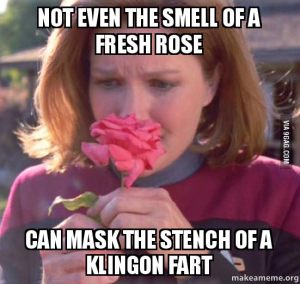Somewhere around third grade, I developed a habit of clasping my hands behind my back, “at ease”-style. I took to saying “Fascinating” whenever the situation even vaguely warranted it. And if I squinted one eye and tilted my head, I could just about fake raising a single eyebrow.
Armchair psychology tells me I identified with Spock because I, too, was the “other,” the outsider, the new kid. But come on – the logic, the dry humor, the ears. What’s not to love?
As I watched Star Trek reruns after school, my loyalties sometimes shifted. Kirk was the best. Scotty was the best. I even underwent a long stretch of naming the seldom seen transporter chief Lt. Kyle as my favorite. But I always came back to Spock, the science officer, the emotionless, super-competent alien.
Eventually, the show itself was not enough. So I bought books. Armed, for the first time, with money that was actually my own – earned by cashing out a savings bond given to me by my grandfather – I begged my mother to drive me to the mall. I made a beeline for Waldenbooks (or was it B. Dalton?) and left with three precious volumes that remain on my shelf today – The Making of Star Trek, The World of Star Trek, and The Trouble With Tribbles.
I devoured them, relishing the reprinted memos, the stories of backstage pranks, and the myriad details that emerged from inside the production. The life I read about on the soundstage was almost as interesting as life depicted on the Enterprise. Pretty soon, though, I started reading boy detective novels and my imaginative adventures began to change.
Yet Leonard Nimoy remained.
As an obsession with bigfoot and the Loch Ness monster and Chariots of the Gods took root, Nimoy appeared on TV to fuel it. In Search Of… provided an infuriatingly catchy theme song as well as frightening speculation behind mysteries that, when looked at now, don’t seem all that mysterious. Yet it pushed me to read even more, to explore, to weigh the evidence for myself.
I discovered Nimoy’s memoir, I Am Not Spock. Inside were photos of the actor in other roles. I was particularly taken by his appearance as King Arthur in Camelot, and vowed that I, too, would one day play that role.
Nimoy starred in Mission: Impossible for two years, including the single most memorable – to me – episode of the entire series, “Submarine.”
He wrote and starred in an acclaimed one-man play about the brothers Vincent and Theo Van Gogh. I followed news of it and could not wait to see the videotaped version run on HBO.
He recorded albums that I both treasured as cheese and fully enjoyed. One song, “You Are Not Alone,” from his debut album, Leonard Nimoy Presents Mr. Spock’s Music From Outer Space, became one that I introduced to college friends. They found it hilarious while also joining me in singalongs.
After watching the first several episodes, I gave up on William Shatner’s cop show, T.J. Hooker. But I tuned back in for Nimoy’s guest appearance.
I memorized a poem from one of Nimoy’s numerous poetry collections. Common wisdom says everyone should know one poem by heart, and mine is titled “Rocket Ships Are Exciting.” I once shouted it aloud, over and over again, from the back of a parade float we titled “Trailer Full o’ Poets.”
When I spotted a memoir by Adam Nimoy, Leonard’s son, I instantly bought it and read it, heartened to learn that Nimoy was fully human, a good if sometimes too career-driven father.
I still find myself clasping my hands behind my back, Spock-style. If someone flashes me a peace sign, I respond with the Vulcan salute. One of my very few pieces of original art is a framed line drawing of Spock.
I guess all of these things, taken together, begin to explain why, for the first time in my life, I cried at the death of a celebrity.
Though I’ve yet to play King Arthur, I did get to perform another role that was, in the long run, much more memorable for me. While still in high school, I put together a cutting from the book I Am Not Spock that encompassed several imagined dialogues Nimoy devised between himself and his alter ego. I performed the piece for a statewide “solo acting” competition. For those few minutes on stage I became, quite literally, both sides of my hero.
It ended with this:
NIMOY: Don’t forget that I’m real and you’re only a fictitious character.
SPOCK: Are you sure?
Written in March 2015 for Shelf Unbound magazine. Later reprinted in the book Spockology.













